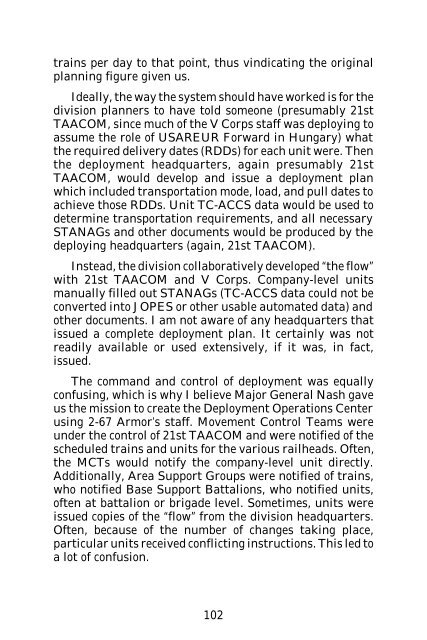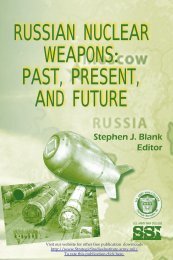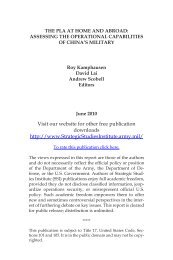Warriors in Peace Operations - Strategic Studies Institute - U.S. Army
Warriors in Peace Operations - Strategic Studies Institute - U.S. Army
Warriors in Peace Operations - Strategic Studies Institute - U.S. Army
You also want an ePaper? Increase the reach of your titles
YUMPU automatically turns print PDFs into web optimized ePapers that Google loves.
tra<strong>in</strong>s per day to that po<strong>in</strong>t, thus v<strong>in</strong>dicat<strong>in</strong>g the orig<strong>in</strong>al<br />
plann<strong>in</strong>g figure given us.<br />
Ideally, the way the system should have worked is for the<br />
division planners to have told someone (presumably 21st<br />
TAACOM, s<strong>in</strong>ce much of the V Corps staff was deploy<strong>in</strong>g to<br />
assume the role of USAREUR Forward <strong>in</strong> Hungary) what<br />
the required delivery dates (RDDs) for each unit were. Then<br />
the deployment headquarters, aga<strong>in</strong> presumably 21st<br />
TAACOM, would develop and issue a deployment plan<br />
which <strong>in</strong>cluded transportation mode, load, and pull dates to<br />
achieve those RDDs. Unit TC-ACCS data would be used to<br />
determ<strong>in</strong>e transportation requirements, and all necessary<br />
STANAGs and other documents would be produced by the<br />
deploy<strong>in</strong>g headquarters (aga<strong>in</strong>, 21st TAACOM).<br />
Instead, the division collaboratively developed “the flow”<br />
with 21st TAACOM and V Corps. Company-level units<br />
manually filled out STANAGs (TC-ACCS data could not be<br />
converted <strong>in</strong>to JOPES or other usable automated data) and<br />
other documents. I am not aware of any headquarters that<br />
issued a complete deployment plan. It certa<strong>in</strong>ly was not<br />
readily available or used extensively, if it was, <strong>in</strong> fact,<br />
issued.<br />
The command and control of deployment was equally<br />
confus<strong>in</strong>g, which is why I believe Major General Nash gave<br />
us the mission to create the Deployment <strong>Operations</strong> Center<br />
us<strong>in</strong>g 2-67 Armor’s staff. Movement Control Teams were<br />
under the control of 21st TAACOM and were notified of the<br />
scheduled tra<strong>in</strong>s and units for the various railheads. Often,<br />
the MCTs would notify the company-level unit directly.<br />
Additionally, Area Support Groups were notified of tra<strong>in</strong>s,<br />
who notified Base Support Battalions, who notified units,<br />
often at battalion or brigade level. Sometimes, units were<br />
issued copies of the “flow” from the division headquarters.<br />
Often, because of the number of changes tak<strong>in</strong>g place,<br />
particular units received conflict<strong>in</strong>g <strong>in</strong>structions. This led to<br />
a lot of confusion.<br />
102
















